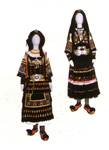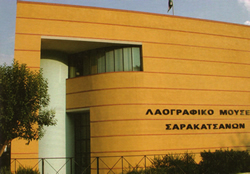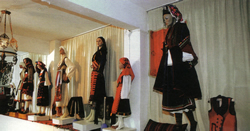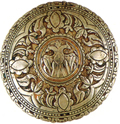FOLKLORE MUSEUMS
THE SARAKATSANI FOLK MUSEUM OF SERRES
Interior of the school with the teacher and his Sarakatsani pupils.
Sarakatsan Thrace - Politiki -Sarakatsan thessaly. The Sarakatsani Folk Museum in Serres is one of the best museums of its kind in Europe. It won the Prix du Musee de l'Anee (Museum of the Year Award) in 1987 in honour of the exhibits that make it unique.The Sarakatsani Folk Museum was opened in 1979, and was initially housed in one of Serres' traditional houses. However, in 1997 the museum moved to its own premises, which gave the museum an entirely new appearance and structure.
The ground floor contains exhibits from the final years as nomads of the Sarakatsanoi, a Greek people with their own unique customs and art. Huts of different sizes and shapes made out of woven grass, give us a marvellous insight into what life must have been like for the shepherds up in their summer pastures. The Sarakatsani school, the shepherd's hut, the cheese-making hut, and the imposing hut decorated with the Sarakatsanoi's best weaving and wood carving are all equally impressive. Exhibited on the first floor of the museum are examples of Sarakatsani weaving, embroidery, and decorated costumes. Exceptional examples of a variety of both men and women's traditional clothing are on view in glass cases, along with a display illustrating the entire weaving process.
Referring to the Chatzilia Museum as the Chatzilia Folklore Museum does not do justice to the depth and breadth of its exhibits, which go far beyond those of a folklore museum. Given the range of its exhibits, both in terms of chronology and subject matter, the best name for the museum would probably be "The Chatzilia Collections".
If all the items in its collections were exhibited correctly, in accordance with modern museum practice, the Chatzilia Collections would constitute a major, self-sufficient museum with well over 5,000 exhibits. Dina and Alekos Chatzilia started the collection in 1965 when they gathered together a number of traditional costumes and items of jewellery.
The reception area is decorated with original photographs taken over the past century or so, as well as photographs of traditional craftsmen at work.Proceeding left into the centre of the museum and then heading right towards the exit, the visitor can enjoy the main bulk of the museum's exhibits, which have been organised into various sections:
Traditional musical instruments;
Traditional women's costumes;
Silver "Tempeliki" (head ornament), 19th century. The Sarakatsani section (costumes, tools, a reconstruction of a Sarakatsani family);
A reconstruction of a traditional Thracian room;
A reconstruction of a traditional room from Asia Minor;
The collection of ecclesiastical and sacerdotal artefacts;
The collection of firearms and swords, the oldest exhibit dating from 2000BC;
The impressively rich collection of traditional jewellery;
The Chatzilia Collections also include the paraphernalia of twenty five traditional trades, most of which are no longer practised, including those of the saddler, the clog-maker, the blacksmith, and the tanner, as well as the equipment once utilised in wooden olive presses and water mills. Limited space means that these artefacts cannot be exhibited.Writers:
Haralampos Vouroutzidis
Athanasios Kanlis






